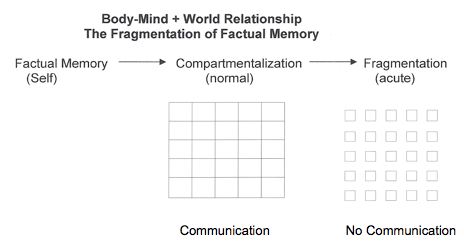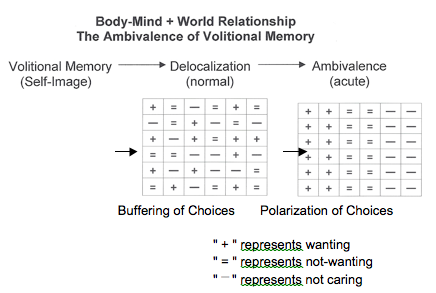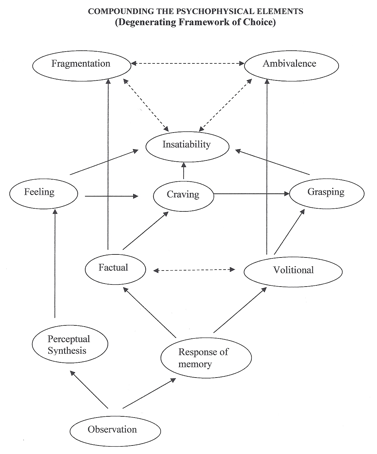Module 2C
In this area we would have a min-nav that would let you jump between modules in the “C” path, or back to The Roadmap.
| SECOND BASIC QUESTION | ORIGINATE & EVALUATE FORMULATION (Level of Invention) |
| #2 WHAT CAUSES IT? | How did I get into this situation? |
2C: The Corruption of the Momentum of Choice: Insatiability, Fragmentation, & Ambivalence
“Neither blindness nor ignorance corrupts people and governments. They soon realize where the path they are taking is leading them. But there is an impulse within them, favored by their habits, which they do not resist; it continues to compel them forward as long as they have a remnant of strength. He who overcomes himSelf is divine. Most see their ruin before their eyes. But they go into it.”
ABSTRACT
Driven by the Insatiability of Selfish Desire, The Fragmentation of Factual Memory and the Ambivalence of Volitional Memory create the fatal double bind: contradictory information is stored as different fragments of the Factual Self but the residue of our psychological movement towards, away from, or ignoring that factual information is stored as the Self-Image. Being cumulative, Volitional Memory is not exclusively associated with the particular Factual Memory that evoked it*, and herein lies the rub. A person experiencing alcoholism cannot piece together a complete factual picture of what has happened to him, nor can he rid himself of his ambivalent feelings towards that fragmented picture. Addiction has trapped him.
CORE IDEA
What matters most with Volitional Memory is that there is a Movement away from “What is” by wanting, not wanting, or ignoring instead of just experiencing “What is.” The Movement creates the Momentum. Although the Movement Away from “What is” has a tripartite origin, it works as a unitary force to distort the Process of making choices. Even if this Momentum of Choice was created by both equal wanting and not wanting, how it manifests depends on conditions in the World that determine which decisions that it supports—and we do not control those conditions. We can only disable the Momentum of Choice as or before it arises, and then eliminate the imprints that it has left within Volitional Memory.
WHAT CAUSES ADDICTION?
| 2A Choice as Cause and Effect | 2B The Proliferation of the Momentum of Choice | 2C The Corruption of the Momentum of Choice |
| Self-centeredness generates a mental obsession for the relief alcohol brings which, after years of destructive drinking, creates a physical phenomenon of craving. | Destructive drinking represents a flight from a conflict of unknown origin in which basic instincts for self-preservation become distorted through a malfunction of memory. | The duality of desire: contradictory experiences of pain and pleasure become irreversibly linked to the act of drinking—one loses the ability to consistently choose to drink or not to drink. |
It takes time to develop simple ideas that work. When you focus all your passion on solving a particular problem, certain conceptual fragments are always there, lurking in the background, waiting to assert themselves at the most opportune moment. After first selecting Feeling, Craving, and Grasping as three formative processes of the Becoming Self, and then distinguishing between Perception, Factual Memory, and Volitional Memory, I was still left with the problem of identifying the culprit that distorted the Self-Image to the degree that an attachment as strong as “Addiction” would set in. How does an impermanent stream of desires “take on a life of its own” as the “Addict” who unceasing believes that security can be found in drinking—or not-drinking (Recovery!)—no matter what the result. The flame of discovery was always smoldering in the background, often blazing forth to interrupt my conscious thoughts or my sleep.
One day, on a 55-minute commute home from my job as a Synthetic Organic Chemist, I turned on my Olympus micro-cassette and began dictating: “Insatiability,” “Fragmentation,” “Ambivalence.” That was all. These three words forced their way into my thoughts and refused to leave. Memory is such a tenuous affair, so I always brought my tape recorder along with me in the car to preserve such moments. Although I cannot be certain, the ideas of Insatiability, Ambivalence, and Fragmentation were probably born from three groups of observations that had through the decades periodically appeared and disappeared along the horizon of my awareness, but had now broken through with sufficient force to demand full attention:
Insatiability. The endemic thirst, dissatisfaction, and longing that are evident at a fundamental level in all human experience: “Enough is never enough.” The “grass is always greener” syndrome seemed to infect everyone that I knew, whether or not they were addicted.
Fragmentation.Psychologically, human beings are not whole, consistent individuals: we don’t act as such, think as such, or even regard ourselves as such upon close examination. We really shouldn’t be surprised: “I’m not myself today” and “I think one thing but do another” head a long list of common expressions that speak to our fragmentation.
Ambivalence. Seen from the perspective of an addict, but not obvious to the external observer, the desire to quit and the compulsion to continue compete with equal ferocity. Over the last 20 years the word “ambivalence” had always kept appearing around the periphery of any activity that touched upon destructive choices: at an AA meeting, in a book, at a movie, in a casual conversation. It was almost whispered, hovering in the air, waiting for someone to hear it. As a Scientist I always heard the word as “Ambi-Valent”—of mixed mind, indecisive.
| Module | The Momentum of Choice | |||
| 1B | Genesis | Perception | Factual Memory | Volitional Memory |
| 2B | Proliferation | Feeling | Craving | Grasping |
| 2C | Corruption | Insatiability | Fragmentation | Ambivalence |
But to what do the terms Insatiability, Fragmentation, and Ambivalence apply? As I pondered their meaning I recalled how I was never able to clearly define the relationship among the phenomenon of craving, self-centeredness, and mental obsession as they manifest in AA’s tripartite model of addictive Desire. I needed a unifying principle
UNIFYING PRINCIPLE: MEMORY
Our efforts become simplified when we can cut through the confusion with a unifying principle. I would soon see that “memory,”—nuanced as Factual Memory and Volitional Memory—would bring Perception, Feeling, Craving, Grasping, Self, Self-Image, Causes and Conditions, Insatiability, Fragmentation, and Ambivalence all under the same conceptual umbrella. Such a powerful integration would allow me to create a practical model of addiction as with transformational and pedagogical clout way beyond anything that I imagined possible.
There is no satisfactory mechanistic explanation for addiction because there is no satisfactory mechanistic explanation for memory. The philosophical ground is rather obtuse. A “materialistic” sees memory as arising from the brain and such a stance seems common sense upon first consideration. But an “interactionist” view of Mind and Body sees memory stored as physical traces in the brain but retrieved by Mind. That there is as yet no satisfactory explanation for how “nonphysical” Mind interacts with “physical” Body only underscores our narrow conceptions of what reality “is.” An “idealist” might go one step further and claim that Body is the effect of Mind, not the other way around.
I looked to the secular empiricists and found that some researchers are beginning to understand the role of memory in addiction. However, all studies that I have read refer necessarily to Factual Memory and do not take into account Volitional Memory, which can only be studied observationally in the laboratory of one’s own life. After reviewing a reasonable amount of current theory and practice on memory processing—the topic most relevant to addiction—I found that current scientific consensus views the multifaceted encoding, storage, and retrieval of memory as involving many areas of the brain working in both cooperation and competition. Some content and functions of memory appear to be localized in specific areas of the brain; some content and functions of memory appear to be delocalized and not specific to any areas of the brain. But how can we apply these concepts of cooperation and competition, of localization and delocalization, to Factual memory and Psycho-Physical Momentum? The unparalleled American genius Charles Sanders Peirce describes the imaginative leap that will break just this kind of impasse:
Sometimes known as “inference to best explanation,” our abductive inference begins by assuming something to be true that we do not know to be true:
In addictive choosing: Factual Memory is fragmented; Volitional Memory is ambivalent.
Here it was! Craving must somehow be associated with the compartmentalization of Factual Memory: the ability to partition would account for why resistance at the level of Craving does not strengthen addiction—it has multiple places, multiple “selves” within which to “hide.” Grasping must somehow be associated with the delocalization of Volitional Memory: the inability to partition would account for why resistance at the level of Grasping strengthens addiction. Factual, compartmentalized memory can be seen as the content of Self, and Volitional, delocalized Memory as the volitional force behind the Self-Image. Factual memory is the water; Volitional Memory is the wave. You can decrease the force of the Momentum of Choice by manipulating the content of Factual Memory, but with severe compartmentalization it is like removing a drop of water from a wave—the results are negligible.
We will now go back to the real world of addiction to see if the impenetrable jungle of facts has been set in order by our huge inductive leap. Unfortunately, the limitations of space will force us to settle for a few personal observations. As always, the reader is encouraged to ask themselves whether this accords with their own experience.
Now armed with the distinction among Feeling, Craving, and Grasping and a new way to understand Factual and Volitional Memory, I suddenly felt empowered to make a huge creative leap and define that elusive moment when someone surrenders their ability to choose as a function of three inextricably bound phenomenon:
- The Insatiability of Self-Centered Desire (as already introduced)—beginning as an exaggeration of the qualities of a Perception (better than it actually is, worse than it actually is, or unimportant when it really is important)—brings you to the moment of compromised choice.
- The Fragmentation of Factual Memory keeps you from recognizing what has happened. (The person who makes the decision is not the same person who has to live with the decision)
- The Ambivalence of Volitional Memory prevents you from doing anything about it even if you do recognize what has happened.
All three Causes and Conditions are necessary and sufficient for an addiction to occur.
Let me comfort the reader who is confused as to what these three statements mean by saying that at the time I wasn’t completely sure what they meant—such speculative discomfort is what the level of Originate & Evaluate often incites. I kept repeating them aloud, over and over, barely able to contain my excitement at their elegant simplicity, their unequivocal decisiveness. Let me remind the reader who is looking for some support for this startling hypothesis that at first I had no concrete evidence other than my gut feeling that this “revelation”—or some version of it—was somehow correct. Much of my confidence arose from the manner in which theory and practice had arisen together throughout my investigation over the previous several years: as soon as I constructed some theoretical idea, circumstances in my life arose to test that idea; when clues began asserting themselves in the raw material of daily life, theories came to mind that could explain those clues. All the effort was now paying off: I had the working beginnings of an explanation of addiction as the corruption of choice, a surrendering to the cycle of indecision.
By combining theory and practice in this manner, we are not just playing with concepts or bowing to the tyranny of personal experience; we are giving names to things that are real so that we can talk about them. We readily acknowledge the gap between the word and what the word describes—the ultimate emptiness of concepts to represent anything adequately. But we can still use concepts as a tool, a preliminary bridge between us and the world that we hope to understand, a world that, as self-conscious creatures, includes us. But to be successful in our practical exploration of ideas we must not become too attached to what we are doing at any given moment. We must be willing to discard any conceptual constructions when they are no longer useful, and constantly remind ourselves that ideas gain importance only to the extent that they move us towards liberation in our daily lives.
And one cannot separate the thought from the thinker. I am deliberately revealing the evolution of these ideas in the manner in which they actually unfolded in my life—some long before I ever knew the role they would play in my own understanding of addiction. If I have been skillful in my efforts, you are learning as I learned, and that is much more valuable than offering knowledge stripped of the manner in which that knowledge was acquired. As creatures that think, we need explanations. Now I needed one that yielded practical knowledge that would be of use to anyone struggling to effect change in their lives. With that in mind, over the next few years I worked out the details of my hypothesis on addiction. Everything fit perfectly.
| EXERCISE 2C: LOCATING THE MOMENT OF CHOICE. Can you tell the difference between a craving—a psychophysical pull, and a mental blank spot—an absent-minded lurching? Intermittent self-awareness; intermittent consciousness; Intermittent Will and choice; reversal of intent and not following through with decisions. Locating the moment of choice (the chooser) do not try to be more aware, be aware of your inattention. We assume things about ourselves that we do not know to be true. |
![]() Are you out of your mind? Alert!
Are you out of your mind? Alert!
All the compounded elements to the Momentum of Choice model can be represented in the following Diagram. The first person to whom I showed this Diagram demonstrated the characteristic honesty and straightforwardness that I demand from people within my orbit: “Are you out of your mind, Michael? No one will be able to understand it!” Even at the risk of discouraging some, the visual serves as a complete representation of decades of work. It is not so much meant to be understand as to be enjoyed as both poignant and ridiculous. This is my model, not yours. The effort to understand it will not guarantee that you will agree with it, but even a modest attempt to see the big picture—the individual elements are more easily accessible—will change the way you think about yourself and the world. And, of course, if you find my model ultimately wanting, then feel free to build your own.
Congratulations! YOU ARE FINISHED STAGE II, LEVELS A, B, & C: What Causes It?
NEXT CHOICES:
START AT THE BEGINNING OF Stage III: 1. What Causes It?
CONTINUE CURRENT LEVEL TO Stage III: 4. Is There A Way Out?




